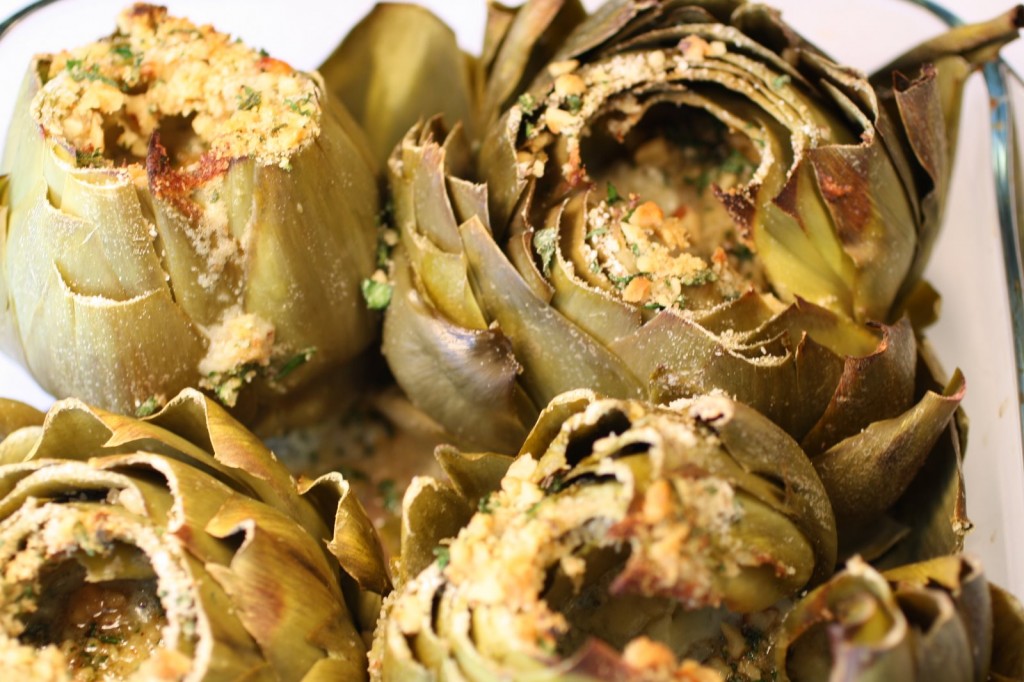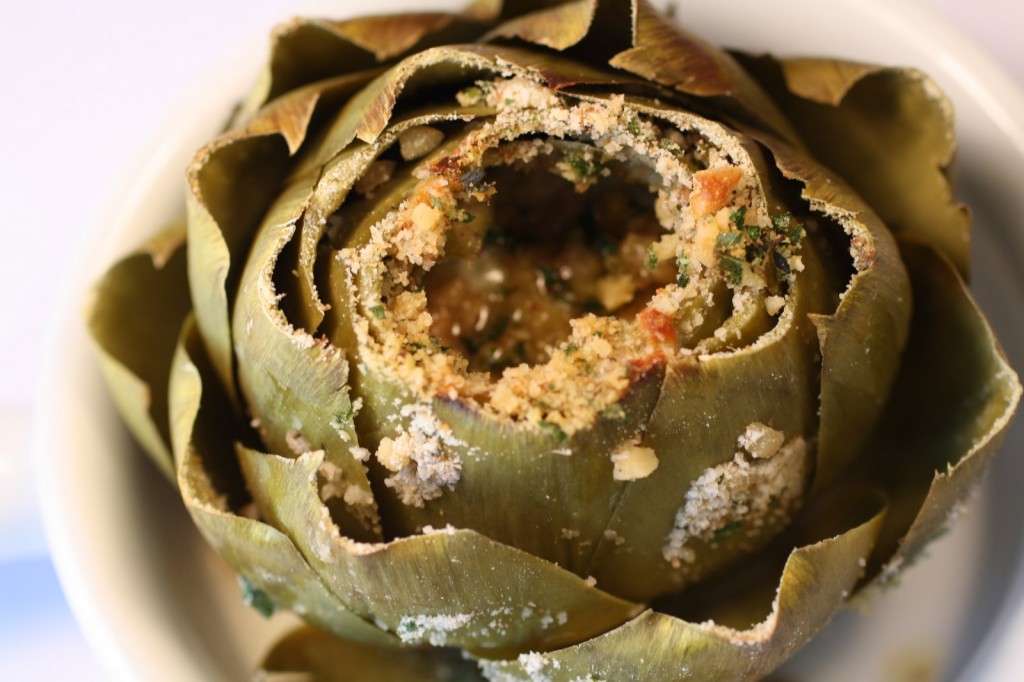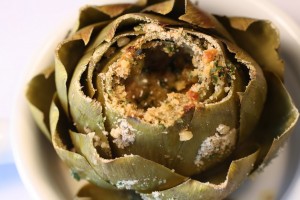For the BBC Radio Oxford, besides Mother’s Day, Father’s Day, and Easter segments, I recorded a series of four courses, for a simple Franco-English dinner that anyone could make any night of the week. This menu is something I adore, and of which I am most proud–and I have finally caught up with its airing schedule. Here is the starter: artichokes filled with a fondue of French blue cheese.
I adore artichokes. Normally, when I have them in France, I order what is called Artichoke Vinaigrette, a chilled steamed artichoke served with a perfect mustardy vinaigrette and some crusty, airy baguette. For me, it is lunchtime heaven. But sometimes it’s good to wander off the beaten path, and this stuffed, baked, nearly gratin-ed version, is a decadent and piquant departure.
 What makes artichokes so wonderful is their instant glamour. You’re not just serving a boiled green vegetable. Everyone gets his own, personal flower. It is the culinary answer to handing someone a bouquet. Plus, it’s so ritualistic. Pull off one petal at a time in a he-loves-me-he-loves-me-not kind of way, and the meal slows down. It gets a bit messy, and people laugh, and chat between the scraping and sucking of leaves. Artichokes are unique; they are fancy enough to impress those who come over but once a year, but fun enough to be a real treat for those with whom you eat each day. This version pairs the everyday verdure of the artichoke with a Marie Antoinette decadence of cream and Roquefort. The time in the oven makes the artichokes crisp and fragrant, and the cream and cheese melt into a little fondue for dipping at the heart of the artichoke.
What makes artichokes so wonderful is their instant glamour. You’re not just serving a boiled green vegetable. Everyone gets his own, personal flower. It is the culinary answer to handing someone a bouquet. Plus, it’s so ritualistic. Pull off one petal at a time in a he-loves-me-he-loves-me-not kind of way, and the meal slows down. It gets a bit messy, and people laugh, and chat between the scraping and sucking of leaves. Artichokes are unique; they are fancy enough to impress those who come over but once a year, but fun enough to be a real treat for those with whom you eat each day. This version pairs the everyday verdure of the artichoke with a Marie Antoinette decadence of cream and Roquefort. The time in the oven makes the artichokes crisp and fragrant, and the cream and cheese melt into a little fondue for dipping at the heart of the artichoke.
- 4 large artichokes
- 1 cup white wine
- 1 lemon
- Salt
- 10.5 ounces/.44 pounds/300 grams Roquefort cheese, at room temperature
- ¼ cup heavy cream
- 2 sprigs thyme, divided
- Pepper
- 2 tablespoons store-bought breadcrumbs
- 2 tablespoons chopped toasted walnuts
- 1 tablespoon parsley
- 2 tablespoons olive oil
A Note on Preparing Artichokes
- Truth be told, trimming an artichoke requires instruction. Don’t be intimidated by the spiny flowers; they are easy to conquer. For this recipe, you’ll want to remove the stems. Using a serrated knife (the one with teeth that you use for bread), saw off the stem of the artichoke right at its base, so it has a flat bottom to sit on in the baking dish. You can cook these stems alongside the artichokes; just remove the thin outer layer of green skin with a paring knife, and cut off the very bottom of the stem. The rest that is exposed is all pale and tender, and very similar to the prized heart.
- Next, you’ll notice that most of the thorny leaf-tops of the artichoke meet at the top of the flower. Using the same serrated knife, cut off the top, about ½ inch or so. Then, because not all the leaves meet at the top, use a pair of kitchen shears to snip the tops off the remaining thorny leaves. This all sounds very complicated, but actually is more like a quick art project that you get to eat afterward.
- Bring a large pot of water to boil. When it reaches a rolling boil, add salt (as if you were cooking pasta) and the white wine. Slice the lemon in half, and squeeze all its juice into the water, then throw the whole lemon in after it.
- While the water is heating, trim the artichokes as instructed above. Cut off the stems so they sit upright. Saw off the top tip. With kitchen shears, snip off the spiny top of each leaf.
- Put the groomed artichokes in the briny, wine-y, boiling water, cover, and cook for 30 minutes.
Procedure
- Preheat the oven to 400 degrees F/205 degrees C.
- Prepare the Roquefort stuffing by combining the soft Roquefort cheese with the cream, the leaves from 1 sprig of thyme, a pinch of salt, and a few grinds of fresh black pepper. Mash together to combine with a fork.
- After 30 minutes, take the artichokes out of their hot bath, and allow them to cool enough so you can handle them. Discard the cooking liquid and lemon. Once the artichokes have cooled, use a small spoon to scoop out the very inner leaves and the choke. You’ll want to be careful when you do this, for if you remove too much, the outer leaves will fall out, and you won’t have a well for your Roquefort. So just lift out the very central, pale leaves, and you will see at the bottom of the well the choke which looks thick husky hair covering the coveted heart. Just remove that hair, and leave the heart.
- Divide the stuffing into 4 parts, and gently pat it into the hollow center of each artichoke, and a bit into the leaves themselves.
- Prepare the topping by combining the leaves from the remaining sprig of thyme, the bread crumbs, the walnuts, the parsley, and salt and pepper. Sprinkle evenly over the artichokes. Drizzle the topping and the artichokes with 2 tablespoons of olive oil.
- Bake for 30 minutes, and you will have a little Roquefort fondue in the center of each artichoke, in which to dip each leaf.








Wow, thats such a wondeful sounding recipe! Your so inventive! I’m just a starter cook but I’ll give it a try. I love your recipes!
This looks like a wonderful recipe. I’ve been looking for a variety of artichoke recipes and happened onto your blog. Wonderful!
I cooked this in French … superb and my guests thought it was a French recipe. It will be on my favourites.
Thanks! I love this recipe–I haven’t made it in so long. I think your comment will help me dig it back out of my recipe box…
The globe artichoke (Cynara cardunculus var. scolymus)[1] is a variety of a species of thistle cultivated as a food. The edible matter is buds that form within the flower heads before the flowers come into bloom. The buds go away or change to a coarse, barely edible form when the flower blooms. The uncultivated or wild variety of the species is called a cardoon. It is a perennial plant native to the Mediterranean region.,
Latest posting on our own website
http://www.caramoan.ph/caramoan-lahus-island/